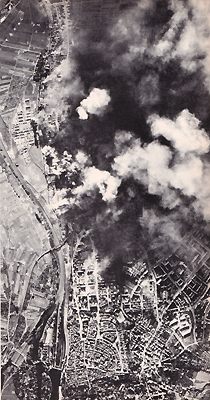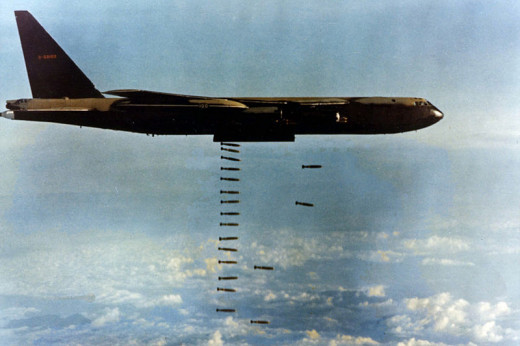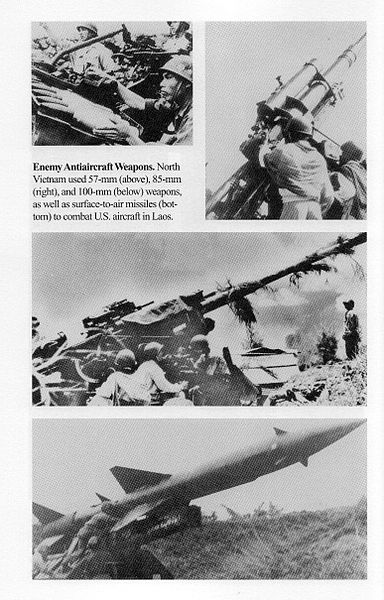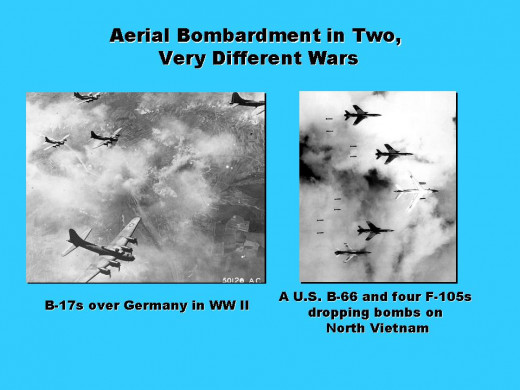- HubPages»
- Education and Science»
- History & Archaeology»
- Military History
U.S. Airpower in the Vietnam War - A Critique
In the early 1980s, I wrote a paper on strategic bombing in the Vietnam War vis-a-vis the laws of war for a seminar at Georgetown University where I was studying for a masters degree. I thought it may still be of interest, if nothing else from a historical standpoint. Here it is with some minor editing and an added update paragraph. Comments welcome!

Introduction
Aerial bombing as an instrument of war is a relatively recent phenomenon in terms of the history of warfare. Utilized somewhat towards the end of World War I, aerial bombing actually came into its own in the Second World War. In that global conflict, air power was used to obliterate entire cities, with wave after wave of bombers dropping thousands of tons of explosives both day and night. This practice continued through the Korean War and into the war in Vietnam, though the methods and objectives varied in each case. The purpose of this article is to focus on the US use of air power, specifically strategic bombing, in the Vietnam war using the previous wars (especially World War II) as points of comparison. In view of the fact that, according to a Cornell University study of airpower in Indochina, the US dropped more tons of ordnance in Southeast Asia than in the other two wars combined, the central question becomes one, essentially, of proportionality: was the US bombing effort in Indochina justified in terms of (1) the military objectives, and (2) international law? This complex question will be the central issue, starting with a review of pertinent aspects of international law as they apply to airpower and, specifically, aerial bombardment. This will be followed by a look at the US effort in Vietnam and past wars vis~a~vis the tenets of the laws of war. Finally, some conclusions will be drawn based on the results of the writer's research into the morality and effectiveness of aerial bombardment.
The Laws of War and Aerial Bombing
The major problem in applying the laws of war to airpower is the fact that the internationally accepted standards adopted at such places as the Hague and Geneva do not sufficiently cover all the aspects of modern aerial warfare, due to the rapid advances made in the use of the airplane in war. In 1925, to an attempt was made to codify some rules of aerial warfare, but the resulting Draft Hague Rules of Air Warfare were never ratified as a treaty by any nation. Thus, the laws of war which generally govern land and naval combat have, essentially, been extended to cover the newer form of air war. The principles of military necessity, proportionality, discrimination, and the related tenets of accepted international law are commonly accepted to be valid in the scrutiny of the use of airpower. For the purpose of this article, only the jus in bello (the way in which warfare is conducted as opposed to jus ad bellum, the justification for going to war) will be examined. A discussion of the justification of the intervention of the US in any given war is not only beyond the scope of this article but is completely academic. On the other hand, due to the fact that aerial combat will certainly play a major role in wars to come, a look at its role in recent wars is highly relevant, both from the standpoint of effectiveness and that of morality. Two articles of previously adopted laws of warfare are especially pertinent to any examination of the legality of the use of airpower. The first is Article 25 of the regulations of the Hague Conventions IV and IX (1907):
"The attack or bombardment, by whatever means, of towns, villages, dwellings, or buildings which are undefended is prohibited."
The second article is Article 22 of the Draft Hague Rules of Air Warfare, 1923:
"Aerial bombardment for the purpose of terrorizing the civilian population, of destroying or damaging private property not of a military character, or of injuring noncombatants is prohibited."
These two articles embody the principle of discrimination, whereupon care must be taken to avoid the destruction or injury to noncombatants during war. Several problems present themselves here, in spite of the apparent straightforwardness of the articles. First, the term "undefended" is open to interpretation, especially in an aerial warfare context. Second, it is not always possible to separate "military" from “civilian” areas (this was especially true in North Vietnam, where the industrial capacity was not centralized as it was, for instance, in the Ruhr in Germany). Legal scholar Morris Greenspan addresses both questions in his writings on the subject:
"Any legal justification of target-area bombing must he based on two factors, The first must be the fact that the area is so preponderantly used for war industry as to impress that character on the whole of the neighborhood, making it essentially an indivisible whole, The second factor must be that the area is so heavily defended from air attack that the selection of specific targets Within the area is impracticable.
In such circumstances, the whole area might be regarded as a defended place from the standpoint of attack from the air, and its status, for that purpose, is assimilated to that of a defended place attacked by land troops. In the latter case, the .attacking force may attack the whole of the defended area in order to overcome the defense, and incurs no responsibility for unavoidable damage to civilians and nonmilitary property caused by the seeking-out of military objectives in the bombardment. Legal justification for target-area bombing would appear to rest upon analogous reasoning."
This reasoning is, essentially, used as the justification for the massive bombing of Axis cities in the Second World War. Air Force Pamphlet 110-31 on international law and aerial combat, from which this quote is taken, asserts that Greenspan's logic is pertinent as far as these bombings were concerned. As an extension of this logic, the nuclear bombings of Japan can be justified since each city contained some military objectives. The fire-bombings of Dresden and other cities, however, do not meet these criteria since they, most experts agree, were done solely to reduce the enemy's morale and his will to win by demoralizing the population. This, of course, is contrary to the articles quoted above. In Indochina, US strategic bombing was not directly comparable to that in World War Il for many reasons, among them the nature of "limited war" and the already mentioned differences between Vietnam and Germany. Greenspan's logic, however, seems to be applicable because of the diffuse nature of North Vietnamese industry, and, especially, the fact that North Vietnam was certainly defended against air attacks. Still, there are conflicting views over the morality, or lack thereof, of the US bombing of North Vietnam as well as in the south and in Cambodia. While discrimination is certainly one issue, proportionality seems to be the major bone of contention. That is, whether the amount of force used by the US was justified in terms of the military objective. Critics argue that entirely too much bombing was done, and, in any case, it had no effect in terms of precipitating a military victory. A Cornell University study of the air war in Indochina done in 1972 concludes:
". . .it would appear that American destruction of nonmilitary targets in Indochina and of objectives not having a purely military character has been grossly disproportionate and excessive in relation to the military gains. The tonnage figures alone depict the inordinate scope of the bombing, and of the seriousness of the violation of law."
The same study then addresses the discrimination issue along with the proportionality question:
"The paucity of purely military targets in Indochina has resulted in frequent bombardment of objectives with a mixed military-civilian character, then largely civilian targets with some military import, and finally civilian targets where enemy units were thought to be (or to have been) located. Thus by the end of 1967 some seventy percent of the villages in Quang Ngai province in South Vietnam had been destroyed, largely because of the actual or suspected presence at one time or another of enemy troops. Pattern bombing and "free-strike" bombing have constituted serious violations of the proportionality rule. The destruction of entire towns and villages throughout Indochina indicates U.S, noncompliance with the law."
The study alleges that the US bombed Vietnamese villages merely because Viet Cong troops had been seen passing through it sometime previously. The net conclusion of the Cornell arguments seems to be that the US suffered from the “We had to destroy the village in order to save it" syndrome. The study's chapter on the Indochina air war and international law does make the point that much further work needs to be done in terms of actually codifying the laws of war vis-a-vis airpower, It is interesting, however, to note that the conductors of the study found existing laws sufficient to condemn virtually the entire US effort in Southeast Asia.
The official view, quite naturally, differs considerably as to the necessity and effectiveness of the US air effort. The argument is made that US airpower, particularly in the north, greatly reduced the enemy's capability to infiltrate men and supplies into South Vietnam. The operations in the north, codenamed "Rolling Thunder", were credited with having an enormous effect on North Vietnam's war effort:
". . .Rolling Thunder had taken a heavy toll of enemy equipment, destroying or damaging several thousand trucks and watercraft, hundreds of railway cars and bridges, many ammunition and storage supply areas, and two-thirds of the enemy's POL storage capacity . . . To counter this air campaign, Hanoi was forced to divert an estimated 200,000 to 500,000 full and part-time workers to repair roads, railway lines, bridges, and other facilities, and to man its air defenses.
Although infiltration southward could not be stopped, U,S. commanders in South Vietnam credited the bombing with reducing the number of enemy battalion-sized attacks."
The above is from The United States Air Force in Southeast Asia, published in 1977 by the 0ffice of Air Force History. Similar claims of success are made in this work about the US air campaign in other parts of Southeast Asia, including the effectiveness of airpower in the South, While little is said concerning the morality of the bombing, the Air Force arguments can be construed to imply that the military advantages gained justified the use of airpower. Thus the argument is substantially one of military necessity. Another official work which considers the bombing in Indochina is "Report on the War in Vietnam" by the Commander-in-Chief Pacific (CINCPAC) in 1968. In a chapter entitled “Effects of Rolling Thunder", the report argues that the campaign had an enormous effect on the North Vietnamese, substantially reducing their war-making capability and, eventually, driving them to the negotiating table. The last paragraph of the chapter is illuminating:
"Perhaps the most important measure of the effects of the bombing, however, would be the consideration of the situation if there had been no bombing at all. The uninhibited flow of men, weapons, and supplies through North Vietnam to confront our forces in South Vietnam could have had only one result for the United States and its allies: considerably heavier casualties at a smaller cost to the enemy. Since this alternative was unacceptable, the bombing of North Vietnam, as an essential element of the overall strategy, was clearly successful in fulfilling its purposes."
Here again, military necessity is the argument used, with the idea that the bombing was proportional in terms of the military advantages gained being implicit. In neither of the above-quoted official works were the laws of War specifically addressed.

Constraints on the US Effort
In any study dealing with US airpower in Indochina, consideration must be given to the fact that extraordinary limitations were placed on US forces which originated directly from the president himself. These constraints, which were rationalized from the standpoint of avoiding a "wider war" or confrontation with Russia or China, severely limited the latitude of US Air Force and Navy commanders, and were often the cause for complaints that the US was "trying to fight a war with one hand tied behind its back." From a standpoint of morality and the laws of war, these constraints could certainly be viewed as an attempt to insure that bombing was done only on purely military targets, and that there was a conscious effort to avoid collateral damage (damage done to civilian or nonmilitary objects located close to the targeted area). While the points made in the Cornell University study quoted previously contained some validity in terms of the US effort in the South, the very fact of the existence of the constraints in the North seems to invalidate some of its conclusions concerning the proportionality of the US bombing in North Vietnam. In point of fact, the argument could be made that the bombing of North Vietnam prolonged the war because it was not enough - i.e., it kept the war going by staving off enemy victory, but the constraints on it prevented it from significantly contributing to victory by the noncommunist forces. This view is substantially that of Nguyen Cao Ky, former Premiere of South Vietnam:
"Many American military leaders did believe they could destroy all North Vietnam‘s major airfields and fuel supplies in the first three days of an all-out air onslaught, but the politicians always ruled that the risks and costs were too great.
Targets had to be approved individually and many important ones were disallowed. So the bombing dragged on, with periodic halts for political maneuvering. Inevitably the bombing escalated and costs rose. In 1965, the first year of the Rolling Thunder campaign, individual flights against North Vietnam totaled 55,000; the tonnage of bombs dropped was 33,000; the aircraft lost numbered 171; and the direct operational costs were $460 million. In 1966 the flights totaled 148,000; the bomb tonnage was 128,000; the aircraft lost numbered 318; and the costs were $1.2 billion. And much of the effect was wasted."
Ky, in his book How We Lost the Vietnam War (1976), goes on to discuss the constraints placed on US pilots and the fact that certain areas of North Vietnam were literally made into sanctuaries, and were not bombed until late in the war. He concludes that war cannot be fought under such conditions. This argument is interesting from an international law standpoint. Is it moral to fight a war under self-imposed limitations in which military victory is virtually impossible thus actually prolonging the war and causing more casualties? This question seems, to the writer, of paramount importance in determining the strategy of airpower for future wars, especially in the context of "limited war."

Some Comparisons with Previous Wars
It is difficult to directly compare airpower in Vietnam with that used in World War Il and Korea. While there were some concerns in the Korean War with respect to avoiding a larger confrontation (somewhat similar to those in Vietnam), there were no such concerns in World War ll., whereupon the maximum use of aerial bombing was made, Arguments have been presented which purport that US bombing in World War ll. was done with "surgical precision" to avoid civilian casualties. The firebombings of Tokyo and Dresden, however, present a different picture. In these cases, the bombing was simply to "break the back" of the enemy in terms of his will to fight. It was also supposed to cause the enemy's civilian population to revolt when they got tired of being bombed. It is generally conceded that; in these respects, the Allied bombing was a failure. In any case, this use of airpower is in direct conflict with the laws of war cited earlier in the article. In the Korean War, B-29s and other aircraft were used to bomb North Korean targets but the bombing was not very effective as the north was not heavily industrialized and the infrastructure destroyed was quickly rebuilt. US aircraft dropped more ordnance on North Korea than they did in the entire Pacific Theatre in World War II but, again, its effectiveness was questionable and may have actually stiffened enemy resolve.
In the case of Vietnam, the bombings were done essentially for military purposes and cannot be directly compared to the "city-busting" of World War II. The constraints placed upon US airpower in Vietnam have no parallel in other wars, nor did the nature of the targets in Vietnam compare with those of Germany and Japan. These differences are important to note when considering the justification of the US use of bombing in Indochina: neither the objectives nor the tactics and strategy were the same as in the two past wars in which airpower played a major role, in spite of the arguments which emphasize total tonnage of air ordnance used in each case.

Conclusions
It would seem, in light of all the above, that the conclusions to be drawn concerning the justification and necessity of the US air effort in Indochina are mixed. The Cornell University study, as mentioned, is valid to a certain degree in terms of the use of aerial bombing to destroy villages to keep them from falling into enemy hands. The recognized laws of war seem to be clear in this regard: they do prohibit the deliberate destruction of non-military areas merely to deny them to the enemy. On the other hand, the bombing of the North seems, for the most part, to have been justified in terms of military necessity, given the fact that the US was involved in the fighting in the South and that the bombing helped to substantially curtail enemy combat effectiveness. Also, it can be argued, it helped to bring North Vietnam to the negotiating table (this is especially true of the "Christmas bombing” on 1972). As far as discrimination is concerned, the constraints placed upon bombing in the north certainly helped to keep civilian casualties minimal, though arguments can certainly be made that this was not the case in the South. Clearly, the US air effort in no case had the effect on civilians that the massive bombings of World War Il had. (Though there were recommendations made on occasion to bomb the dikes in North Vietnam, an action which would have caused great loss of life. US leadership decided against this, even when North Vietnam disregarded the previously signed Peace Accords and massively invaded the South bringing about the demise of the Saigon government.)
The proportionality issue is the most interesting of all, perhaps, in that it can be argued, as in the Cornell study, that US bombing was out of proportion to the military objectives. It can also be argued; as Ky does, that the bombing was not enough, at least at first. When the bombing was escalated, the North had an incredibly effective air defense, making the effort even more costly. What seems clear is that, in terms of military victory, the effectiveness and justification of the air effort in Indochina are not proven by the final result. If military necessity is used as justification, the fact that the air war did not preclude the ultimate Communist victory can only lead to one conclusion -- the air war was a failure in Indochina. Ironically, this was not due to the superiority of enemy forces; rather primarily to the ultimate lack of will on the US side. This leads us to the question which really must be answered: is it justifiable, morally or otherwise, to conduct a war which is not meant to end in victory?
Update
Obviously modern warfare has changed considerably from some thirty years ago. New technology has brought us "stealth" aircraft and aerial dropped munitions which are far more accurate and discriminating. The use of airpower in the former Yugoslavia and in Iraq and Afghanistan has proven its effectiveness in spades, especially with respect to the use of pilotless aircraft to take out enemy personnel. (Two days before this was written, the Israelis were able to target a single automobile from the air and eliminate a Hamas terrorist leader using, what the Israelis called, "advanced technologies.") In spite of the increasing effectiveness of airpower, however, wars still need to be fought as a combined arms effort, at least in the opinion of this writer. Of course, if there ever is, God forbid, a strategic nuclear exchange between two or more nuclear powers, then all bets are off.








